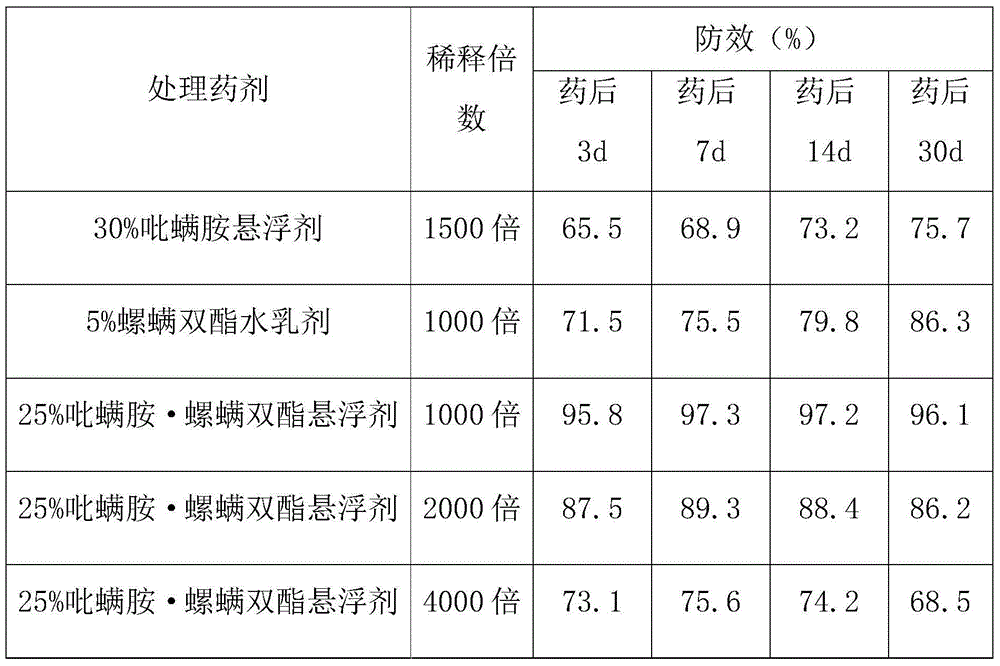Synergistic acaricidal composition containing tebufenpyrad and spirodiclofen
A technology of spirodiclofen and pyrimidine, which is applied to pesticide and acaricidal compositions and application fields thereof, can solve problems such as crop damage and acaricide resistance, and achieves delaying drug resistance, improving control effect, and reducing pesticide use. amount of effect
- Summary
- Abstract
- Description
- Claims
- Application Information
AI Technical Summary
Problems solved by technology
Method used
Image
Examples
Embodiment 5
[0028] Formulation example 5: 35% tebufenfen·sirobudiclofen water-dispersible granules.
[0029] Tebuflufen 28%, Spirobufen 7%, Alkylphenol Polyoxyethylene Ether 10%, Sodium Dodecyl Benzene Sulfonate 10%, Sodium Carbonate 3%, Polyvinyl Alcohol 2%, Kaolin make up 100%. Mix the above-mentioned effective ingredients, dispersant, wetting agent, disintegrant, binder and filler uniformly, pulverize with an ultra-fine jet mill, knead, and then add to a fluidized bed granulation dryer for granulation, drying, By sieving, 35% tebufenfen-spirondiclofen water-dispersible granules can be prepared.
Embodiment 1
[0030] Biological Assay Example 1: Indoor Joint Toxicity Determination of Tebufenpyrad and Spirofendiclofen to Panonychus citrus
[0031] The test agent used 93% of the original drug of tebufenfen and 97% of the original drug of spirobudiclofen.
[0032] The test insects were Panonychus citrus nymphs collected from citrus orchards and reared indoors for 3 generations.
[0033] The test method adopts the leaf butterfly spray method (refer to "NY / T 1154.13-2008 Pesticide Indoor Bioassay Test Guidelines for Insecticides. Part 13: Leaf butterfly spray method"). The specific operation method is as follows:
[0034] Set 5 different concentration gradients for each single agent and mixed agent (on the basis of preliminary test results, the mortality rate of Panonychus citrus nymphs is set in a proportional progression within the range of 5%-90%).
[0035] Select citrus leaves with consistent growth, make leaf butterflies with a puncher, place a wet sponge block in a petri dish, put...
Embodiment 2
[0045] Biological Assay Example 2: Field efficacy test of tebufenpyrad and spirobudiclofen compound against Panonychus citrus.
[0046]Adopt 25% tebufenpyrad-spirondiclofen suspension concentrate (preparation embodiment 1) to be used for preventing and treating Panonychus citrus, investigate the insect population base before spraying, investigate the number of residual living mites respectively after 3d, 7d, 14d, and 30d after the medicine, During the investigation, 2 plants were checked in each plot, and 5 leaves of each plant were checked in four directions, east, west, north, south, respectively. A total of 40 leaves were checked in each plot, the number of live mites was recorded, and the control effect was calculated. The control effect calculation method is as follows:
[0047] Control effect (%) = (1-CK 1 ×Pt 1 / CK 2 ×Pt 2 )×100.
[0048] Among them: CK 1 Represents the number of worms in the control area before the drug; Pt 1 Represents the number of insect popu...
PUM
 Login to View More
Login to View More Abstract
Description
Claims
Application Information
 Login to View More
Login to View More - R&D
- Intellectual Property
- Life Sciences
- Materials
- Tech Scout
- Unparalleled Data Quality
- Higher Quality Content
- 60% Fewer Hallucinations
Browse by: Latest US Patents, China's latest patents, Technical Efficacy Thesaurus, Application Domain, Technology Topic, Popular Technical Reports.
© 2025 PatSnap. All rights reserved.Legal|Privacy policy|Modern Slavery Act Transparency Statement|Sitemap|About US| Contact US: help@patsnap.com



